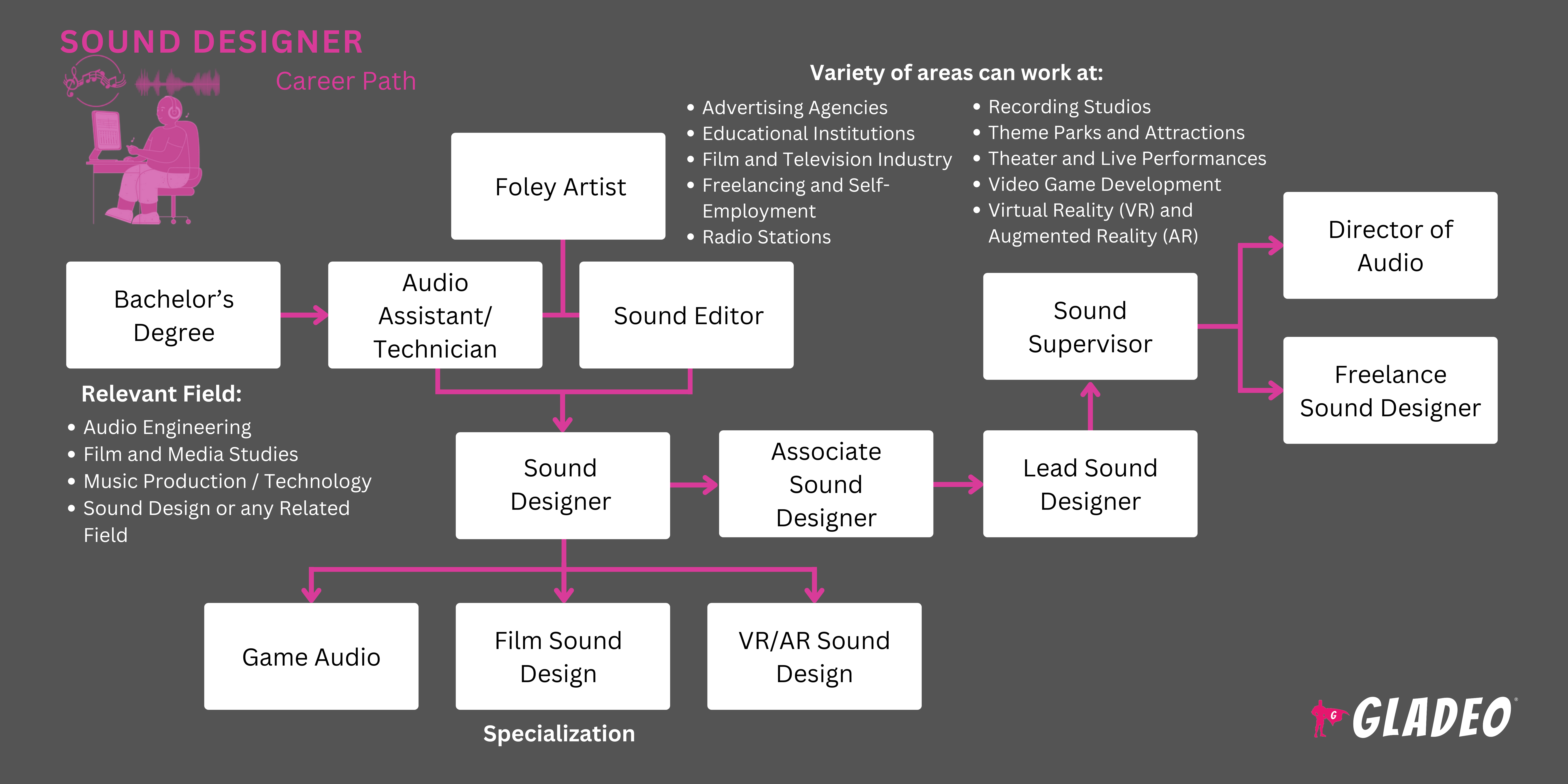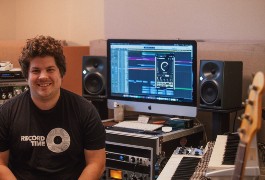Spotlights
Audio Engineer, Audio Operator, Mastering Engineer, Mixer, Mixing Engineer, Recording Engineer, Sound Editor, Sound Engineer, Sound Technician, Studio Engineer, Theatrical and Broadcast Technicians
Ever wondered who’s behind the sounds in movies or the background music in video games? Meet Sound Designers – the unsung heroes of the entertainment world. These auditory wizards shape the soundscape of productions ranging from blockbuster films and TV shows to games and live performances. They use state-of-the-art software to mix sound effects, dialogue, and music to create and manipulate audio elements that enhance what we’re watching. From explosions and dragon roars to footsteps or gentle ocean waves, if it makes a noise, they’re involved somewhere in the process!
Sound Designers work closely with directors and producers to understand the vision and mood of a production. Then they get to work recording real-world sounds, making new sounds in a studio, cutting and editing audio clips, and mixing sound elements to create balanced, immersive audio tracks. The job requires a unique blend of creative skills and technological talent to make all those iconic soundscapes that audiences often take for granted!
- Enhancing the emotional impact of stories through sound
- A measure of creative freedom to design interesting sounds and soundscapes
- Collaborating with directors, producers, and other creative professionals
- Working with cutting-edge audio technology
Lịch làm việc
- Many Sound Designers work full-time, with overtime possible. They may work in studios, on location, or from home. Project-based work is also common, especially for contractors or freelancers hired for specific one-time projects such as films, video games, advertisements, and live events.
Nhiệm vụ tiêu biểu
- Attend production meetings to understand the project’s creative vision and audio requirements
- Provide sound design concepts and present audio samples for feedback and approval
- Make adjustments based on input, ensuring the final audio aligns with production goals
- Capture high-quality audio on set or in a studio, ensuring clear, accurate recordings
- Travel to locations to capture authentic environmental sounds, such as cityscapes, nature sounds, or unique acoustic spaces
- Perform and record Foley sounds – everyday sound effects created in sync with the picture, like footsteps, rustling clothes, or breaking objects
- Create original sound effects to enhance scene moods and realism in movies, TV shows, video games, and live performances
- Use practical recording techniques and digital tools to generate unique sounds
- Experiment with everyday objects and environments to find unexpected sound effects
- Edit audio tracks to remove unwanted noise, adjust levels, and sync with visual elements
- Mix audio tracks, balancing sound effects, dialogue, and music to create cohesive auditory experiences
- Ensure audio elements are perfectly synchronized with visual cues and timings
- Use software to match sounds and dialogue with the on-screen action
- Conduct quality checks to ensure audio sounds great when played from various output sources
- Adjust mixes to meet the requirements of different media formats and playback systems
- Implement consistent audio standards across all project outputs
- Collaborate with post-production teams to ensure the audio complements the final cut
- Discuss and implement last-minute changes or adjustments as needed
- Troubleshoot technical issues during recording or post-production to ensure high-quality sound
As Berklee College of Music notes, “The main job of a sound designer is to search through commercial audio libraries to find the right sounds for a project, or, when the right sounds cannot be found or licensed, record sounds in the studio or the field and process them through a digital audio workstation (DAW) to create the desired effect or tone.” As “jacks-of-all-trades,” Sound Designers are also responsible for “placing mics, recording and editing dialogue, and recording and editing field sounds.”
Trách nhiệm bổ sung
- Organize and maintain an extensive library of sound effects, music tracks, and recordings
- Continuously seek out new sound effects libraries, musical pieces, and audio samples
- Stay tuned to trends in sound design and music to keep productions fresh and relevant
- Explore new software, plugins, and hardware to enhance capabilities
- Attend industry workshops, conferences, and training sessions to stay current in the field
- Maintain proficiency through ongoing practice and professional development courses
- Check and maintain audio equipment (microphones, recorders, mixing consoles, etc.)
- Mentor and train new sound designers or audio technicians
Kỹ năng mềm
- Lắng nghe tích cực
- Khả năng thích nghi
- Chú ý đến chi tiết
- Communication
- Creativity
- Tư duy phản biện
- Decision-making
- Flexibility
- Đa nhiệm
- Kỹ năng tổ chức
- Tính kiên nhẫn
- Giải quyết vấn đề
- Stress management
- Team collaboration
- Quản lý thời gian
Kỹ năng kỹ thuật
- Proficiency with audio editing software (e.g., Pro Tools, Logic Pro)
- Knowledge of sound recording techniques
- Familiarity with audio hardware and software
- Understanding of acoustics and sound theory
- Experience with digital audio workstations (DAWs) like Ableton Live and FL Studio
- Sound synthesis and sampling using tools like Native Instruments Kontakt and Serum
- Surround sound mixing and mastering
- Field recording with portable audio recorders (e.g., Zoom H5, Tascam DR-40)
- Proficiency with MIDI programming and sequencing
- Sound library management and organization
- Knowledge of audio formats and codecs
- Use of audio plugins and effects processors (e.g., Waves, FabFilter)
- Experience with Foley recording techniques
- Understanding of audio signal flow and patching
- Sound restoration and noise reduction using software like iZotope RX
- Film and television production companies
- Audio post-production houses and service providers
- Sound design studios and collectives
- Video game developers
- Theaters and live performance venues
- Advertising agencies
- Recording studios
Audiences don’t always notice the behind-the-scenes efforts of Sound Designers–but it takes long hours of hard work and attention to detail to ensure sound work is done right. Each recording project comes with unique requirements and deadlines, and it takes commitment to the craft to perfect every detail.
Sound Designers must be proficient with a wide range of software and equipment. But the technology doesn’t stand still, so they’ve got to learn new things constantly. Despite the pressure to keep up, the role can be incredibly rewarding when designers see how their work affects the projects they’re involved in!
One of the most exciting trends in sound design is the use of immersive technologies like Dolby Atmos to create three-dimensional spatial audio experiences. This trend is gaining traction in cinemas, home entertainment systems, and even personal devices, revolutionizing how we experience sound.
The demand for sound design in virtual and augmented reality applications is also on the rise. As these technologies become more mainstream, the need for high-quality, immersive audio to enhance will continue to grow. One of the challenges associated with this trend is that designers must create audio environments that respond realistically to user interactions.
Advancements in AI, digital audio workstations, and audio plugins continue to push the boundaries of what Sound Designers can achieve. Staying updated with these complex changes is essential for workers who want to stay competitive in the industry.
When they were younger, Sound Designers often enjoyed playing musical instruments, experimenting with recording equipment, and creating their own sound effects. They likely had a keen interest in movies and video games, paying close attention to the audio elements that enhanced the overall experience.
- A bachelor’s degree in audio engineering, sound design, music production, or a related field is often required. Some Sound Designers learn on their own and get a certification from a media school versus a full degree
- Common college courses might include:
- Acoustics
- Audio Signal Flow
- Audio Technology
- Digital Audio Workstations (DAWs)
- Field Recording: Capturing Sound Effects and Ambient Noise
- Microphone Techniques
- Music Composition and Arrangement
- Music Theory
- Sound Editing, Mixing, and Mastering
- Sound Synthesis
- Sound Wave Physics
- Practical experience is beneficial and can be gained through internships in studios, production houses, or media companies
- Aspiring Sound Designers should work on a short sound design demo reel, editing it to feature their best work as they gain experience and proficiency. Reels should clearly label the designer’s work and responsibilities related to each clip
- Popular optional certifications include:
- Ableton Certified Trainer
- Apple - Logic Pro X Certification
- Audinate - Dante Certification
- Avid Certified User: Media Composer
- Avid Certified Professional: Media Composer
- Avid Certified User: Pro Tools
- Society of Broadcast Engineers - Certified Audio Engineer
- SoundGym Certified Audio Engineer
- Steinberg Certified Training
- Wwise Certification
- Decide on a program format (on-campus, online, or hybrid) that suits your needs.
- Seek an accredited program at a school with strong audio engineering, sound design, or music production programs.
- Programs should feature state-of-the-art audio equipment and studios.
- Ideally, programs should offer internships or co-op programs with industry partners.
- Weigh the cost of tuition against available financial aid and scholarship opportunities.
- Assess faculty qualifications and alumni accomplishments.
- Consider post-graduation outcomes like job placement rates.
- In high school, take ad hoc courses in music, technology, and media production either at school or online (such as on Udemy, Coursera, or LinkedIn Learning
- Think about the types of projects you want to work on, such as films, TV, or video games
- As Justin French, CEO and Audio Director of Dream Harvest notes, “Learn to critically listen to your surroundings and take note of how every sound reacts to a room or space. This is an essential skill when mixing sound effects in order to make them sound natural.”
- Join audiovisual clubs. Participate in music and theater productions to gain practical experience
- Seek internships or part-time work in audio production, or consider freelancing to get experience with real clients
- Build a portfolio for your sound design demo reel
- Stay updated with industry trends and advancements by reading articles and watching informational videos (see our list of Recommended Tools/Resources > Websites)
- Study the careers of audio pioneers like Ben Burtt, sound designer for Star Wars, Raiders of the Lost Ark, WALL-E, and other popular films
- Reach out to do an informational interview with a working Sound Designer. See if you can shadow them at work for a day
- Collaborate with other creatives. Work on projects together in your free time, to get practice
- Join online sound design-related discussion groups and professional organizations like the Theatrical Sound Designers and Composers Association
- Review job posts and job descriptions to see what current qualifications and specializations employers are looking for

- Review job postings on Indeed and other job boards
- Look for entry-level positions or internships at film and television production companies, audio post-production houses, sound design studios, collectives, video game developers, or related employers
- Scan job posts for keywords and work those keywords into your resume, if applicable
- Relevant resume keywords might include:
- Ableton Live
- Audacity
- Audio Editing
- Audio Restoration
- Cubase
- Digital Audio Workstations (DAWs)
- Field Recording
- FL Studio
- Logic Pro
- Mastering
- Mixing
- Pro Tools
- Sound Design
- Sound Effects
- Sound Forge
- Review some Sound Designer resume templates for ideas
- Make a professional LinkedIn profile and website to showcase your demo reel/portfolio
- Reach out to your network to let them know you’re looking for a job
- Attend professional events such as conferences, workshops, or job fairs
- Be patient. Apply for internships, apprenticeships, co-op programs, and entry-level positions
- Ask your academic program manager if they have ties with local employers or recruiters
- Consider relocating to be close to where there are more job opportunities
- Check out Sound Designer interview questions to prepare yourself
- Brush up on relevant terminology and industry trends
- Ask former supervisors and college professors for references or recommendation letters
- Utilize your university’s career center for resume help and mock interviews
- Dress professionally for job interviews
- Talk with your supervisor about advancement opportunities. If you work for a small studio, you may have to switch employers to move up
- Volunteer to take on team leadership roles or tackle complex projects
- Keep up with new audio technologies, techniques, and industry standards through continuous education and practice
- Be creative and experimental. Try to “think outside the box” and come up with innovative new sounds and techniques
- Finish certifications from audio engineering schools or specific software companies, such as Apple - Logic Pro X Certification, Audinate - Dante Certification, or Avid Certified User: Pro Tools
- Building connections with industry professionals through events and online platforms
- Participate in professional organizations like the Theatrical Sound Designers and Composers Association
- Maintain good working relationships with directors, producers, and other production team members
- Knock out a graduate degree to deepen your expertise
- Train and mentor junior colleagues so they can to perform their best work
- Consider launching your own sound design studio!
Trang web
- Ableton
- A Sound Effect
- Association of Sound Designers
- Audio Engineering Society
- Audio Media International
- Audiovisual and Integrated Experience Association
- Avid (Pro Tools)
- BOOM Library
- Creative Field Recording
- Designing Sound
- Game Audio Network Guild
- International Game Developers Association
- iZotope
- Kadenze - Sound Design for the Web
- Mix Magazine
- Pensado’s Place
- Point Blank Music School
- Pro Sound News
- Resolution Magazine
- Sonic Academy
- SoundGirls
- Sound on Sound
- SoundWorks Collection
- Steinberg (Cubase)
- The Pro Audio Files
- Theatrical Sound Designers and Composers Association
- Waves Audio
Sách vở
- Principles of Game Audio and Sound Design, by Jean-Luc Sinclair
- Sound Design: The Expressive Power of Music, Voice and Sound Effects in Cinema, by David Sonnenschein
- Studying Sound: A Theory and Practice of Sound Design, by Karen Collins
- The Foley Grail, by Vanessa Theme Ament
- The Sound Effects Bible: How to Create and Record Hollywood Style Sound Effects, by Ric Viers
Sound design projects can be a lot of fun, but it’s not always easy to find full-time work. There are many alternative career options that also leverage skills in audio technology, creative sound manipulation, and production, such as:
- Acoustic Consultant
- Audiobook Narrator
- Audio Engineer
- Audio Programmer
- Audio Technician
- Broadcast Technician
- DJ/Remixer
- Foley Artist
- Live Sound Engineer
- Music Composer
- Music Producer
- Podcast Producer
- Post Production Engineer
- Radio Producer
- Recording Engineer
- Sound Archivist
- Sound Editor
- Voice Over Artist
Nguồn cấp tin tức

Công việc nổi bật

Các khóa học và công cụ trực tuyến








